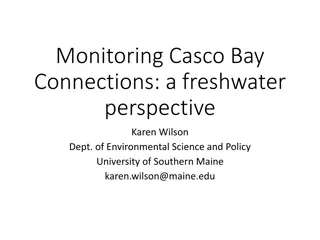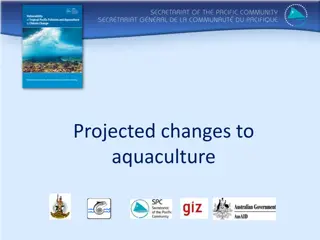Understanding Batrachospermum: A Freshwater Red Alga
Batrachospermum, a red alga commonly found in freshwater habitats like streams, ponds, and lakes, is characterized by its beautiful, gelatinous thallus structure. The plant body grows up to 15-20 cm and exhibits varying colors based on light exposure. Its thallus is differentiated into prostrate and
3 views • 17 slides
Understanding Freshwater Biodiversity: Invertebrate Bio-indicators
Explore how invertebrates like stoneflies, mayflies, and caddisflies can be used as bio-indicators to determine water quality in freshwater habitats. Each species has specific environmental requirements, making their presence or absence a valuable tool for assessing the health of freshwater ecosyste
0 views • 16 slides
Algae Diversity: Habitats and Classification
Algae exhibit remarkable diversity in habitats, including halophytic algae in salt lakes, symbiotic algae with various organisms, cryophytic algae on ice, thermophytes in hot springs, and more. They are classified into different groups based on pigmentation, storage products, and cellular organizati
0 views • 22 slides
Exploring Freshwater Ecosystems: Lakes, Ponds, and More
Freshwater ecosystems offer a diverse range of habitats, from lakes and ponds to wetlands and rivers. These ecosystems host a variety of organisms adapted to different zones based on factors like sunlight and nutrients. Plankton, nekton, and benthos are key aquatic groups, with unique roles in the e
0 views • 24 slides
Exploring Our Freshwater Ecosystems and Taking Action for Conservation
Discover the beauty of our freshwater ecosystems through stunning images of rivers, lakes, and wildlife. Learn about the challenges threatening these vital resources, such as overuse, pollution, and dam constructions. Find out how we can make a difference by using water efficiently, preventing pollu
1 views • 9 slides
Understanding Blue-Green Algae: Cultivation, Nutrient Composition, and Properties
Blue-green algae, also known as cyanobacteria, are photosynthetic bacteria that thrive in warm, nutrient-rich water bodies. They are packed with essential nutrients like vitamins, minerals, and amino acids, making them a valuable resource for overall health. Learn about the cultivation, uses, and hi
1 views • 21 slides
SRAP Markers: Feasible Tool for Invasion Genetics of Freshwater Fish
Molecular tools, like Sequence-Related Amplified Polymorphism (SRAP) markers, play a crucial role in studying invasion genetics of freshwater fish. SRAPs offer a reliable and efficient way to assess genetic diversity and variations in non-native species, aiding in population genetics studies of inva
1 views • 5 slides
Freshwater Edible Fishes: A Culinary Delight
Freshwater fishes are a valuable food source in tropical regions. With high protein content, essential nutrients, and great taste, popular varieties like Labeo Rohita, Catla Catla, and Cirrhinus Mrigala offer a delicious and nutritious culinary experience. Learn about their characteristics, breeding
0 views • 31 slides
Characteristics of Phaeophyta - Brown Algae (Seaweeds)
Phaeophyta, also known as brown algae or seaweeds, exhibit unique characteristics including cellulose fibers with Alginic acid, food reserves like laminarin and mannitol, and a life cycle consisting of both haploid and diploid stages. They possess photosynthetic pigments giving them their brown colo
1 views • 26 slides
Studies in the Use of Algae in Fish Nutrition by Dr. Peter Perschbacher
Dr. Peter Perschbacher, an Associate Professor at the University of Arkansas, specializes in exploring the benefits of algae in fish nutrition. His research interests include polycultures, algae as fish meal replacements, alligator gar ecology, and more. He has received numerous honors and awards fo
0 views • 28 slides
Freshwater Fluxes from Greenland and Climate Regime Changes in the Arctic-North Atlantic System
Freshwater fluxes from Greenland are identified as a new regulator of climate regime changes in the Arctic-North Atlantic system. The Arctic Ocean Oscillation Index reveals two circulation regimes with alternating patterns. Correlations between the Arctic Ocean Oscillation and various environmental
1 views • 32 slides
Exploring Freshwater: A Vital Resource on Earth
Water, the universal solvent, exists in various forms and covers 71% of the Earth's surface. Freshwater, crucial for life, is limited with only a small percentage available for organisms. River basins play a vital role in water distribution and quality. Understanding the importance of freshwater res
2 views • 5 slides
Review of Water Quality Standards TR17 Updates & Chloride Criteria
Updates in the Triennial Review of Water Quality Standards TR17 regarding chloride criteria for water quality in Pennsylvania were presented to the Citizens Advisory Council. The need for protecting aquatic life statewide due to negative impacts from chloride concentrations, as well as insights on t
0 views • 19 slides
Understanding Protists: Unicellular Organisms and Their Classification
Protists are diverse unicellular organisms that can be classified based on their nutrition and movement methods. They include protozoans, algae, and heterotrophs like molds, each playing unique roles in ecosystems. From Didinium to multicellular algae, explore the fascinating world of these microsco
0 views • 8 slides
Importance of Algae in Various Industries
Algae have significant economic importance as they serve as primary producers, food sources, fodder for animals, bio-fertilizers, and aids in soil reclamation. They play a crucial role in oxygen production, water pollution reduction, and are utilized in industries such as iodine extraction. Algae ar
0 views • 51 slides
Monitoring Casco Bay Connections: A Freshwater Perspective
Explore the freshwater-marine linkages in Casco Bay, Maine through the lens of monitoring efforts in the Presumpscot River watershed. Dive into the alewife spawning runs, water quality checks, and restoration timeline to understand the delicate balance between freshwater and marine ecosystems.
0 views • 12 slides
The Fascinating World of Algae and Protists
Algae, diatoms, dinoflagellates, euglenoids, and red algae are diverse plant-like protists crucial for Earth's ecosystems. They range from unicellular to multicellular forms, contributing significantly to oxygen production and food chains. While some like red algae thrive in deep ocean waters, other
0 views • 20 slides
Understanding Algae: Classification, Habitat, and Reproduction
Algae are chlorophyllous thallophytes that thrive in aquatic environments, producing their own food and oxygen through photosynthesis. They are categorized based on habitat as aquatic, terrestrial, aerophytes, cryophytes, and thermophytes. The three main classifications of algae are Chlorophyceae (g
0 views • 16 slides
Identification of Aquatic Plants in Freshwater Bodies Based on Habitat Classification
Before identifying aquatic plants in freshwater bodies, it's vital to classify them into floating macrophytes, marginal macrophytes, submerged macrophytes, and emergent macrophytes. This classification aids in distinguishing various plant species such as Eichhornia, Salvinia, Pistia, Lemna, and Azol
0 views • 9 slides
Classification of Algae, Economic, and Ecological Significance, Bryophytes Overview
Algae, classified into green, brown, and red types, play crucial roles in food, industry, and ecology. Green algae are significant in symbiotic relationships, while red and brown algae provide commercial products. Algae are vital producers in aquatic ecosystems, contributing to ecological balance. B
0 views • 18 slides
Understanding Earth's Freshwater Sources and Watersheds
Earth's freshwater distribution is a critical aspect of our planet's ecosystems. This content provides insights into the percentage of freshwater on Earth, the significance of groundwater and aquifers, the impact of watersheds on water quality, and the vast Mississippi River watershed. It highlights
0 views • 8 slides
Insight Into the Adaptations and Habits of Aquatic Freshwater Eels
The Anguillidae family includes freshwater eels with snake-like bodies, dwelling in diverse habitats. Their catadromous nature involves migrating to the ocean to breed. Freshwater eels serve dual roles as predator and prey, displaying unique feeding behaviors. Their body structures feature elongated
0 views • 15 slides
Innovative Algae Pond Project Collaboration in Kansas
Collaborating with multiple organizations including KDHE, KSU Vet Diagnostic Lab, and KSRE Water Quality Specialists, a project in Kansas is utilizing barley straw to address blue-green algae in ponds. The project involves dosing ponds with barley straw at specific rates and locations, along with re
0 views • 11 slides
Algae: Oceans' Unsung Heroes
Algae play a critical role in our planet's ecosystem, outnumbering plants on land. The oceans are teeming with microscopic algae and seaweeds, essential for marine life. Without algae, our oceans would be barren, highlighting their crucial ecological importance.
0 views • 45 slides
Aquaculture Adapting to Climate Change: Insights and Strategies
Aquaculture faces evolving challenges due to climate change. Freshwater and coastal aquaculture, focusing on tilapia, milkfish, freshwater prawn, and marine species, are explored. The vulnerability of aquaculture is highlighted, along with potential benefits and risks posed by climate change. Strate
0 views • 25 slides
Main Characteristics of Rhodophyta: The Red Algae Division
Rhodophyta, or red algae, are mostly marine algae with distinct photosynthetic pigments giving them a red color. Their main characteristics include the presence of phycoerythrin pigment, floridean starch as food reserve, thalloid plant body structure, oogamous sexual reproduction, and cell walls con
0 views • 27 slides
Understanding Earth's Water Distribution
Earth, known as the Water Planet, is covered by about 71% water and 29% land. There are two main kinds of water - freshwater and saltwater. The oceans hold approximately 96.5% of Earth's water, with the remaining as freshwater in lakes, glaciers, and ice caps. The distribution of water plays a cruci
0 views • 15 slides
Global Algae
Algae by Type (Macroalgae\/Seaweed {Red, Brown}, Microalgae {Spirulina, Chlorella, D. Salina}), Distribution Channel (B2B, B2C), Form (Dry, Liquid), Application
0 views • 5 slides
Fascinating Insights into Lichens: Algae, Fungi, and Ecological Succession
In the world of lichens, a unique symbiotic relationship between algae and fungi thrives, showcasing the wonders of mutualism. Through photosynthesis, algae produce glucose and oxygen, while fungi provide stability and protection on rocks. This partnership plays a crucial role in primary succession,
0 views • 4 slides
Factors Affecting Algal Ecology: Light Intensity Impacts on Algae Growth and Composition
Light intensity plays a crucial role in the growth and composition of algae. Algae undergo photoadaptation processes to adjust to varying light levels, affecting their photosynthetic efficiency and cellular properties. High light intensity can lead to photoinhibition and changes in cellular composit
0 views • 19 slides
Understanding Algal Culture Media for Lab Growth
Algae in natural habitats acquire essential nutrients from water, but for lab cultivation, specialized growth media are necessary. Various types of algal culture media exist, each with specific nutrient components like nitrogen, phosphorus, vitamins, and trace metals. Common media include marine alg
0 views • 6 slides
Understanding Algae: General Characteristics, Occurrence, and Classification
Algae, studied in algology or phycology, are autotrophic organisms with chlorophyll, primarily found in aquatic environments. They exhibit a variety of structures, pigments, and reproduction methods. Algae are classified into 11 classes based on criteria such as pigmentation, reserve food, and thall
0 views • 27 slides
Exploring the Fascinating World of Algae: A Visual Journey Through Different Phyla
Dive into the diverse and intriguing realm of algae with this visual guide. From the catchall kingdom Protista to the distinct phyla Chlorophyta, Phaeophyta, Rhodophyta, Bacillariophyta, Dinoflagellata, and more, learn about their characteristics, structures, and importance. Discover how green algae
0 views • 32 slides
Factors Influencing Algae Growth in Water Ecosystems
Nutrients play a crucial role in algae growth, with inorganic nutrients like nitrogen and phosphorus being key factors. Algae require macroelements such as carbon, hydrogen, oxygen, sulfur, potassium, calcium, phosphorus, and nitrogen in large quantities, as well as microelements like iron, manganes
0 views • 16 slides
The Future of Algae Fuel: A Promising Solution for America's Energy Needs
Algae biofuel technology is essential for improving fuel sources in America. Algae's high lipid content makes it a pure source of biodiesel, with bio-engineered strains now containing up to 80% lipid. Algae fuel production, while promising, is a tedious and expensive process. Despite the challenges,
0 views • 8 slides
Exploring the Fascinating World of Algae: Characteristics, Types, and Applications
Delve into the intriguing realm of algae, from their general characteristics to the various types such as Diatoms, Green Algae, Blue-Green Algae, Yellow-Green Algae, and Red Algae. Algae range from microscopic to seaweed, serving as autotrophic organisms with reproductive structures like gametangia.
0 views • 16 slides
Utilization of Algae for Biofuels Production: A Comprehensive Overview
Algae, both microalgae and macroalgae, hold immense potential as sources of biofuels due to their high productivity and adaptability. Microalgae, in particular, are highlighted for their rapid growth rates and efficient photosynthesis, making them ideal for mass production with minimal land and wate
0 views • 31 slides
Exploring Algae: Biodiversity, Importance, and Habitats
Delve into the world of algae with Professor Olubukunola O. Oyesiku as he discusses the classification, economic importance, natural habitats, and ecological contributions of algae. Learn about the unique features that distinguish algae from other plants and explore their fossil record dating back 1
0 views • 54 slides







































